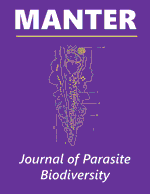Parasitology, Harold W. Manter Laboratory of

MANTER: Journal of Parasite Biodiversity
Date of this Version
10-5-2023
Document Type
Article
Citation
MANTER: Journal of Parasite Biodiversity (October 5, 2023) number 33
doi: 10.32873/unl.dc.manter33
Abstract
D-shaped nematode eggs in the feces of Rangifer tarandus are expected to be oxyurid nematodes (Nemata: Oxyurida) of the genus Skrjabinema. The species S. tarandi is considered species-specific for this host. There is no consensus regarding the cross-infection of reindeer and sheep with S. ovis and S. tarandi. The drawings proposed by descriptors complicate differential diagnostics. Micrographs of S. tarandi eggs obtained via light microscopy and scanning electron microscopy as well as photographs of S. ovis eggs and drawings made on their basis are proposed to confidently distinguish between representatives of these two species, taking into account morphometric data. Thus, the egg of S. tarandi has a thickening on the convex side, in contrast to the egg of S. ovis. It is shown that because of the specific feeding habits of R. tarandus, D-shaped eggs of parasitic nematodes of small rodents can also be found in their feces. The latter should be considered spurious parasites.
D-образные яйца нематод в фекалиях северного оленя, как ожидается, принадлежат оксиуридным нематодам (Nemata: Oxyurida) рода Skrjabinema. Вид S. tarandi считается видоспецифичным для этого хозяина. Нет единого мнения относительно перекрестного заражения северных оленей и овец нематодами S. ovis и S. tarandi. Рисунки, предложенные видоописателями, затрудняют дифференциальную диагностику. Предложены изображения яиц S. tarandi, полученные при световой и сканирующей электронной микроскопии, а также снимки яиц S. ovis (световая микроскопия) и выполненные на их основе рисунки, позволяющие уверенно различать представителей этих двух видов с учётом морфометрических данных. Так, яйцо S. tarandi имеет вздутие на выпуклой стороне, в отличие от яйца S. ovis. Показано, что из-за специфических пищевых привычек северных оленей в их фекалиях могут встречаться D-образные яйца нематод-паразитов мелких грызунов. Последних следует считать ложными паразитами.


Comments
Copyright © 2023, Loginova
License: CC BY-NC-SA 4.0 International